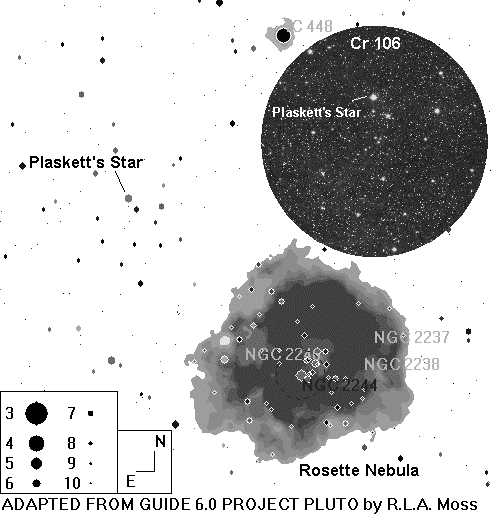Plaskett, John Stanley (1865–1941)

Plaskett's Star lies east of 13 Monocerotis and is very probably a member of NGC 2244, which in turn is part of the Rosette Cluster.
John Plaskett was a Canadian astronomer and mechanical engineer who, in 1918, became director of the newly established Dominion Astrophysical Observatory (DAO) in British Columbia, for which he had organized the design, construction, and installation of a new 72-inch (1.8-meter) reflecting telescope.
Plaskett's field of research was spectroscopy, in particular the measurement of radial velocities of celestial bodies, i.e., their velocities along the line of sight, from the shift in their spectral lines. Using the 72-inch reflector and a highly sensitive spectrograph which he had also designed, many spectroscopic binary systems were discovered. In 1922, Plaskett identified an extremely massive star as a binary, now known as Plaskett's Star (see below).
In 1927 Plaskett provided confirmatory evidence for the theory of galactic rotation put forward by Bertil Lindblad and Jan Oort. By 1928, in collaboration with Joseph Pearce, he had obtained evidence for the hypothesis formulated by Arthur Eddington in 1926 that interstellar matter was widely distributed throughout the Galaxy; their discovery that interstellar absorption lines, mainly of calcium, took part in the galactic rotation, showed that interstellar matter was not confined to separate star clusters. Although this result was first announced by Otto Struve in 1929, Plaskett felt he had priority and was convinced that Struve had obtained his results from him. He retired from the DAO in 1935.
 |
| John Plaskett
|
Plaskett's Star
Plaskett's Star (V640 Mon) is a spectroscopic binary,
of visual magnitude 6.05, lying about 5,000 light-years away in the constellation Monoceros. It is named after John Plaskett who, in 1922, discovered the system's great claim to fame: it was at the
time, and until recently, the most massive binary star system known. According
to a recent estimate, the two components, both blue
supergiants of type O8, are respectively
51 and 43 times more massive than the Sun. They orbit around their common
center of gravity with a period of just 14.4 days and are exchanging material.
Plaskett's Star is found just east of 13 Monocerotis and is very probably
a member of NGC 2244, which in turn is part of the Rosette Cluster.


